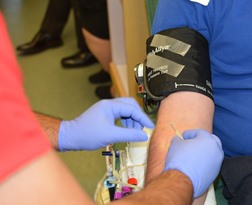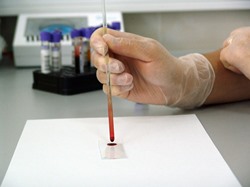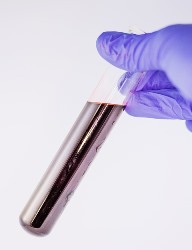Selecting a Phlebotomy Training Program near Protection Kansas
 Picking the ideal phlebotomy technician school near Protection KS is an essential first step toward a fulfilling career as a phlebotomist. It might seem like a challenging undertaking to evaluate and compare each of the school alternatives that are available to you. However it’s necessary that you complete your due diligence to make certain that you receive a quality education. In reality, many students start their search by looking at two of the qualifiers that first come to mind, which are cost and location. Another option you may consider is whether to attend online classes or commute to an area campus. We’ll discuss more about online classes later in this article. What’s important to remember is that there is far more to checking out phlebotomy training programs than finding the closest or the cheapest one. Other factors such as reputation and accreditation are also important considerations and should be part of your decision process too. Toward that end, we will supply a list of questions that you need to ask each of the phlebotomy schools you are reviewing to help you pick the ideal one for you. But before we do that, let’s cover what a phlebotomist is and does, and afterwards continue our discussion about online classes.
Picking the ideal phlebotomy technician school near Protection KS is an essential first step toward a fulfilling career as a phlebotomist. It might seem like a challenging undertaking to evaluate and compare each of the school alternatives that are available to you. However it’s necessary that you complete your due diligence to make certain that you receive a quality education. In reality, many students start their search by looking at two of the qualifiers that first come to mind, which are cost and location. Another option you may consider is whether to attend online classes or commute to an area campus. We’ll discuss more about online classes later in this article. What’s important to remember is that there is far more to checking out phlebotomy training programs than finding the closest or the cheapest one. Other factors such as reputation and accreditation are also important considerations and should be part of your decision process too. Toward that end, we will supply a list of questions that you need to ask each of the phlebotomy schools you are reviewing to help you pick the ideal one for you. But before we do that, let’s cover what a phlebotomist is and does, and afterwards continue our discussion about online classes.
Phlebotomist Career Description
 A phlebotomist, or phlebotomy tech, draws blood from patients. While that is their principal duty, there is actually much more to their job description. Prior to drawing a blood sample, a phlebotomist needs to confirm that the tools being employed are single use only and sterile. After collection, the sample must be properly labeled with the patient’s information. Next, paperwork needs to be correctly filled out to be able to track the sample from the time of collection through the lab screening procedure. The phlebotomist then delivers the blood to either an in-house lab or to an outside lab facility where it can be tested for such things as infectious diseases, pregnancy or blood type. Many Protection KS phlebotomists in fact work in laboratories and are in charge of making certain that samples are tested properly under the strictest quality control procedures. And if those weren’t enough responsibilities, they can be called upon to train other phlebotomists in the collection, delivery and follow-up process.
A phlebotomist, or phlebotomy tech, draws blood from patients. While that is their principal duty, there is actually much more to their job description. Prior to drawing a blood sample, a phlebotomist needs to confirm that the tools being employed are single use only and sterile. After collection, the sample must be properly labeled with the patient’s information. Next, paperwork needs to be correctly filled out to be able to track the sample from the time of collection through the lab screening procedure. The phlebotomist then delivers the blood to either an in-house lab or to an outside lab facility where it can be tested for such things as infectious diseases, pregnancy or blood type. Many Protection KS phlebotomists in fact work in laboratories and are in charge of making certain that samples are tested properly under the strictest quality control procedures. And if those weren’t enough responsibilities, they can be called upon to train other phlebotomists in the collection, delivery and follow-up process.
Where do Phlebotomy Techs Work?
The most basic answer is wherever there are patients. Their work places are numerous and diverse, including Protection KS medical clinics, hospitals, nursing homes, or blood centers. They may be charged to draw blood samples from patients of of every age, from infants or toddlers to senior citizens. Some phlebotomy techs, depending on their training and their practice, specialize in collecting samples from a particular kind of patient. For instance, those working in an assisted living facility or nursing home would solely be drawing blood from senior patients. If they are working in a maternity ward, they would be drawing blood from mothers and newborns exclusively. On the other hand, phlebotomists working in a general hospital environment would be drawing samples from a wide range of patients and would collect samples from new patients each day.
Phlebotomy Education, Licensing and Certification
 There are primarily two kinds of programs that furnish phlebotomy training in Protection KS, which are certificate and degree programs. The certificate program usually takes less than a year to finish and furnishes a basic education as well as the training on how to draw blood. It offers the quickest route to becoming a phlebotomy tech. An Associate of Science Degree in Clinical Laboratory Science, although not specifically a phlebotomist degree, will provide training on becoming a phlebotomy tech. Available at junior and community colleges, they typically require 2 years to finish. Bachelor’s Degrees are less available and as a four year program provide a more expansive background in lab sciences. Once you have completed your training, you will no doubt want to get certified. While not required in the majority of states, most employers look for certification before employing technicians. A few of the primary certifying organizations include:
There are primarily two kinds of programs that furnish phlebotomy training in Protection KS, which are certificate and degree programs. The certificate program usually takes less than a year to finish and furnishes a basic education as well as the training on how to draw blood. It offers the quickest route to becoming a phlebotomy tech. An Associate of Science Degree in Clinical Laboratory Science, although not specifically a phlebotomist degree, will provide training on becoming a phlebotomy tech. Available at junior and community colleges, they typically require 2 years to finish. Bachelor’s Degrees are less available and as a four year program provide a more expansive background in lab sciences. Once you have completed your training, you will no doubt want to get certified. While not required in the majority of states, most employers look for certification before employing technicians. A few of the primary certifying organizations include:
- National Phlebotomy Association
- National Healthcareer Association (NHA)
- American Society for Clinical Pathology (ASCP)
- American Medical Technologists (AMT)
There are some states that do require certification in order to practice as a phlebotomy tech, like Nevada and California. California and a handful of other states even require licensing. So it’s important that you pick a phlebotomy training program that not only offers a quality education, but also prepares you for any licensing or certification examinations that you are required or elect to take.
Online Phlebotomist Colleges
 To start with, let’s resolve one potential mistaken belief. You can’t get all of your phlebotomy training online. A significant component of the program of studies will be clinical training and it will be performed either in an approved Protection KS healthcare facility or an on-campus lab|an on-campus lab or an approved healthcare facility}. Many courses also require completing an internship in order to graduate. But since the non-practical part of the training may be attended online, it may be a more practical alternative for some students. As an additional benefit, some online programs are more affordable than their traditional competitors. And some expenditures, such as those for textbooks or commuting, may be lessened also. Just confirm that the online phlebotomy school you enroll in is accredited by a regional or national accrediting agency (more on accreditation later). With both the comprehensive online and clinical training, you can obtain a quality education with this approach to learning. If you are dedicated enough to learn at home, then earning your certificate or degree online may be the ideal choice for you.
To start with, let’s resolve one potential mistaken belief. You can’t get all of your phlebotomy training online. A significant component of the program of studies will be clinical training and it will be performed either in an approved Protection KS healthcare facility or an on-campus lab|an on-campus lab or an approved healthcare facility}. Many courses also require completing an internship in order to graduate. But since the non-practical part of the training may be attended online, it may be a more practical alternative for some students. As an additional benefit, some online programs are more affordable than their traditional competitors. And some expenditures, such as those for textbooks or commuting, may be lessened also. Just confirm that the online phlebotomy school you enroll in is accredited by a regional or national accrediting agency (more on accreditation later). With both the comprehensive online and clinical training, you can obtain a quality education with this approach to learning. If you are dedicated enough to learn at home, then earning your certificate or degree online may be the ideal choice for you.
What to Ask Phlebotomist Colleges
Since you now have a basic idea about what is involved in becoming a phlebotomy tech, it’s time to initiate your due diligence process. You may have already decided on the kind of program you want to enroll in, whether it be for a certificate or a degree. As we previously mentioned, the location of the Kansas college is significant as well as the tuition expense. Maybe you have opted to enroll in an online phlebotomy program. All of these decisions are an important part of the process for selecting a program or school. But they are not the sole concerns when making your decision. Below we have provided a few questions that you need to ask about all of the Protection KS schools you are considering before making your ultimate decision.
Is the Phlebotomist Program Specific to Your State? As mentioned previously, each state has its own requirements for practicing as a phlebotomist. Several states require certification, while a few others mandate licensing. Each has its own requirement regarding the minimum hours of practical training performed before working as a phlebotomist. As a result, you may have to pass a State Board, certification or licensing exam. Therefore it’s very important to select a phlebotomy program that fulfills the state specific requirements for Kansas or the state where you will be practicing and readies you for all examinations you may have to take.
Is the Program Accredited? The phlebotomist school and program you enroll in should be accredited by a respected regional or national accrediting agency, such as the National Accrediting Agency for Clinical Laboratory Sciences (NAACLS). There are many benefits to graduating from an accredited program aside from an assurance of a premium education. To begin with, if your program has not received accreditation, you will not be able to take a certification examination administered by any of the earlier listed certifying agencies. Also, accreditation will help in securing financial aid or loans, which are typically unavailable for non-accredited schools in Protection KS. Last, earning a certificate or a degree from an accredited college can make you more attractive to future employers in the job market.
What is the School’s Reputation? In numerous states there is little or no regulation of phlebotomy schools, so there are some that are not of the highest caliber. So in addition to accreditation, it’s important to check the reputations of any schools you are looking at. You can begin by requesting references from the schools from employers where they place their graduates as part of their job assistance program. You can screen online school reviews and rating services and solicit the accrediting agencies for their reviews as well. You can even talk to some Protection KS local clinics or hospitals that you might be interested in working for and find out if they can provide any recommendations. As a closing thought, you can contact the Kansas school licensing authority and ask if any complaints have been filed or if the colleges are in total compliance.
Is Sufficient Training Provided? First, check with the Kansas regulator or the state regulator where you will be working to find out if there are any minimum requirements for the amount of training, both clinical and classroom. As a minimum, any Protection KS phlebotomy program that you are considering should provide no less than 40 hours of classroom training (most require 120) and 120 hours of clinical training. Anything below these minimums might indicate that the program is not comprehensive enough to offer adequate training.
Are Internships Provided? Find out from the Kansas schools you are looking at if they have an internship program in collaboration with regional health care facilities. They are the optimal means to get hands-on practical training typically not obtainable on campus. As an added benefit, internships can help students develop relationships within the local Protection KS healthcare community. And they look good on resumes as well.
Is Job Placement Assistance Available? Getting your first phlebotomist job will be a lot easier with the support of a job placement program. Ask if the programs you are reviewing offer assistance and what their job placement rate is. If a college has a higher rate, meaning they place the majority of their students in jobs, it’s an indication that the program has both a good reputation together with an extensive network of professional contacts within the Protection KS medical community.
Are Class Times Compatible With Your Schedule? And last, it’s important to verify that the final college you choose offers classes at times that are compatible with your active schedule. This is particularly true if you opt to still work while going to school. If you can only go to classes in the evenings or on weekends near Protection KS, make certain they are offered at those times. Additionally, if you can only attend on a part-time basis, make sure it is an option as well. Even if you have decided to attend online, with the practical training requirement, make sure those hours can also be fulfilled within your schedule. And ask what the make-up procedure is in case you have to miss any classes due to illness or emergencies.
Why Did You Want to Be a Phlebotomy Tech?
When preparing to interview for a Phlebotomist job, it's helpful to reflect on questions you might be asked. One of the things that interviewers typically ask Phlebotomist candidates is "What made you choose Phlebotomy as a profession?". What the interviewer is trying to learn is not just the personal reasons you may have for becoming Phlebotomist, but also what qualities and skills you possess that make you exceptional at your profession. You will likely be asked questions relating exclusively to Phlebotomy, along with a significant number of routine interview questions, so you should prepare several strategies about how you want to respond to them. Since there are numerous variables that go into selecting a career, you can answer this fundamental question in a variety of ways. When readying an answer, aim to include the reasons the work interests you as well as the abilities you possess that make you an exceptional Phlebotomy Tech and the ideal choice for the job. Don't make an effort to memorize an answer, but jot down several concepts and talking points that relate to your personal experiences and strengths. Reviewing sample responses can help you to prepare your own thoughts, and provide ideas of what to include to impress the recruiter.Find the Ideal Phlebotomist Program near Protection KS
Making sure that you pick the ideal phlebotomy training is an important first step toward your success in this rewarding health care field. As we have discussed in this article, there are a number of factors that contribute toward the selection of a quality program. Phlebotomy certificate or degree programs are offered in a number of educational institutes, including community or junior colleges, trade schools, and colleges and universities that provide an extensive array of programs in healthcare and medical sciences. Program offerings can differ a bit across the country as every state has its own prerequisites when it concerns phlebotomy training, licensing and certification. The most critical point is that you must thoroughly screen and compare each school prior to making your final decision. By addressing the questions that we have provided, you will be able to narrow down your choices so that you can pick the right school for you. And with the appropriate training, you can accomplish your goal of becoming a phlebotomist in Protection KS.
Learn About Protection Kansas
Protection, Kansas
Protection is a city in Comanche County, Kansas, United States. As of the 2010 census, the city population was 514.[6]
Protection was founded in 1884.[7] Popular support for a protective tariff in the 1884 presidential election caused the name to be selected.[8] The first post office in Protection was established on August 27, 1884.[9]
The town became nationally and internationally known via radio and television in 1955–1956, when the National Polio Foundation chose it as the center for the free distribution of Salk vaccine shots for polio. It then became 100 percent protected.[10]
Protection is located at 37°12′5″N 99°29′0″W / 37.20139°N 99.48333°W / 37.20139; -99.48333 (37.201316, -99.483403).[11] According to the United States Census Bureau, the city has a total area of 0.95 square miles (2.46 km2), all of it land.[1]
More Interesting Kansas Cities
Protection KS Blood Labs - BingNews Search results
-
Lab-grown blood vessels could soon become reality
One of the companies furthest along is Humacyte, a Durham, N.C.-based biotech that makes lab-grown blood vessels, which could help patients with traumatic injuries along with those who use ...
-
Radiation Protection in the Cardiac Catheterization Laboratory
Cardiac Catherization Laboratory, The Heart Centre, Rigshospitalet, University of Copenhagen, Blegdamsvej 9, DK-2100, Copenhagen, Denmark Tel.: +45 3545 2770 Fax: +45 3545 2705 kari.saunamaki@rh ...
-
The Best Antivirus Software for 2024
In the years since that fateful meeting, I’ve become PCMag’s expert on security, privacy, and identity protection, putting antivirus tools, security suites, and all kinds of security software ...
-
McAfee Total Protection Review
In the years since that fateful meeting, I’ve become PCMag’s expert on security, privacy, and identity protection, putting antivirus tools, security suites, and all kinds of security software ...
-
Lab-grown diamonds are ethical, cheaper, blood-less. So why aren't they as popular?
Gen Z and millennials are especially attracted to lab-grown diamonds, Disha says, because of "ethical sourcing and sustainability compared to natural diamonds, given the concerns around blood ...
-
Protection, KS Current Weather
Solar max is nearly here! Here’s how and where to see the Northern Lights ...
-
Blood Diamonds
It is an industry that was supposed to be cleaned up, after the turn-of-the-millennium notoriety surrounding so-called blood or conflict diamonds—precious stones mined in African war zones ...
-
Laboratory Medicine
Most faculty members are responsible (Section Head) of one or more clinical laboratory and are responsible for the analysis of blood, urine, body fluids and tissue used for the diagnosis and ...
-
Ecological Protection Lab
The UNG Ecological Protection Lab (formerly the Beetle Lab) has led in regional efforts to protect the Eastern Hemlock from the invasive Wooly Adelgid by initiating biological control efforts through ...
-
Wood Protection Group Laboratory Testing
AWPA Standard, E10, Standard Method of Testing Wood Preservatives by Laboratory Soil-Block Cultures. Also, ASTM D1413 and WDMA TM-1. The soil block decay test is a highly standardized means for ...
-
HWA Management Strategies
The UNG Ecological Protection Lab primarily breeds two species of beetles: Lacricobius nigrinus (Ln) and Sasajiscymnus tsugae (St). Our lab, along with UGA and Young Harris, obtain a small amount of ...
-
When to worry about blood test results
Under a new federal directive, commercial labs are required to give patients ... I asked him whether the technician had a difficult time drawing blood. He replied that indeed she had, leaving ...
